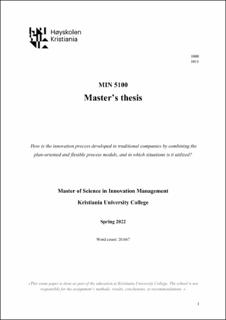| dc.description.abstract | This paper analyzes how the innovation process is developed in traditional companies by combining the plan-oriented and flexible process models, and in which situations it is
utilized. To answer the research question, a multiple case study was selected. This research compared three traditional manufacturing companies within the same industry with in-depth interviews, follow-up interviews, observations, and secondary research. Traditional manufacturing companies today have begun to focus more on innovations, even so, how they organize for innovation differ amongst the companies. Five out of the eight boundary conditions presented by Paluch et al., (2019), proved highly important for the traditional companies researched, but the findings revealed investment and time influence, strategic fit and willingness to change and mindset to be of equal importance for selecting the general Hybrid innovation process. Nevertheless, three separate situations were revealed to affect the development of the combined process in traditional manufacturing companies. These situations were then based on four out of nine conditions initially found through both expected and observed pattern matching during the analysis; investment, consumer preferences, managerial control, and approach to risk. The different combination of the conditions resulted in three situation-based approaches to the Hybrid process model: short-term incremental-, short-term radical- and long-term radical innovations. From a theoretical perspective, this study emphasizes a need for a combined process. When considering large traditional manufacturing companies’ approach to innovation and how the degree of leaning towards the Agile or Stage-Gate method, whilst still being a Hybrid process, highly varies based on the innovational situation related to time and radicality. From a practical perspective, the three combined processes developed through research can serve as a guideline for innovation managers and help simplify the practice for mutual understanding of how to organize the innovation process based on three separate situations. | en_US |

